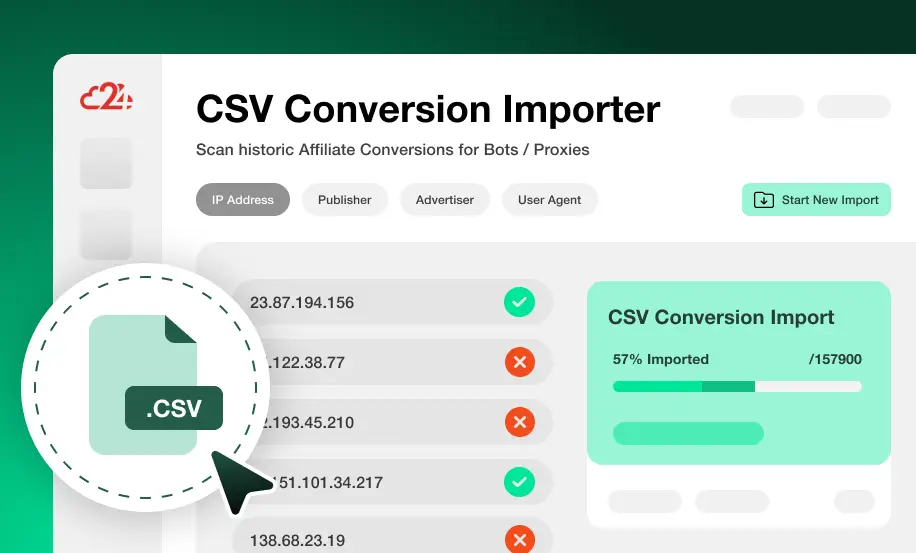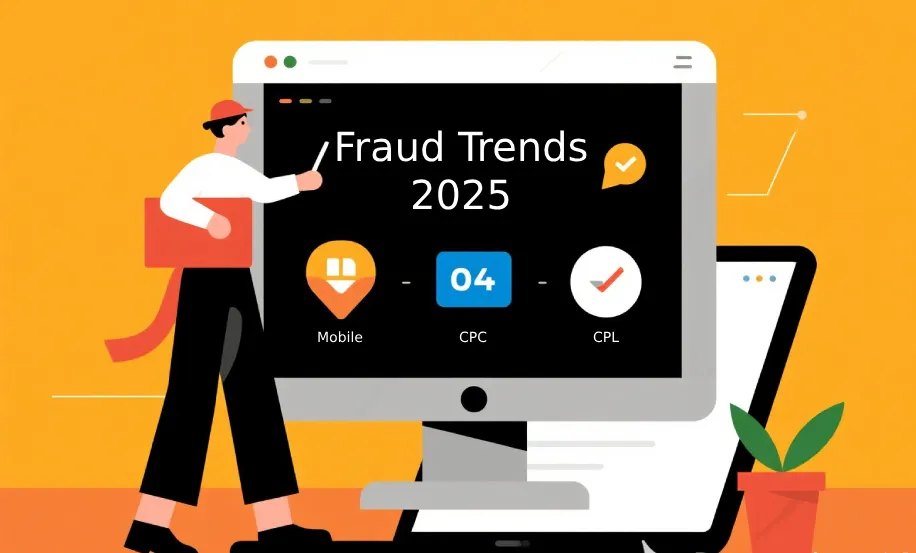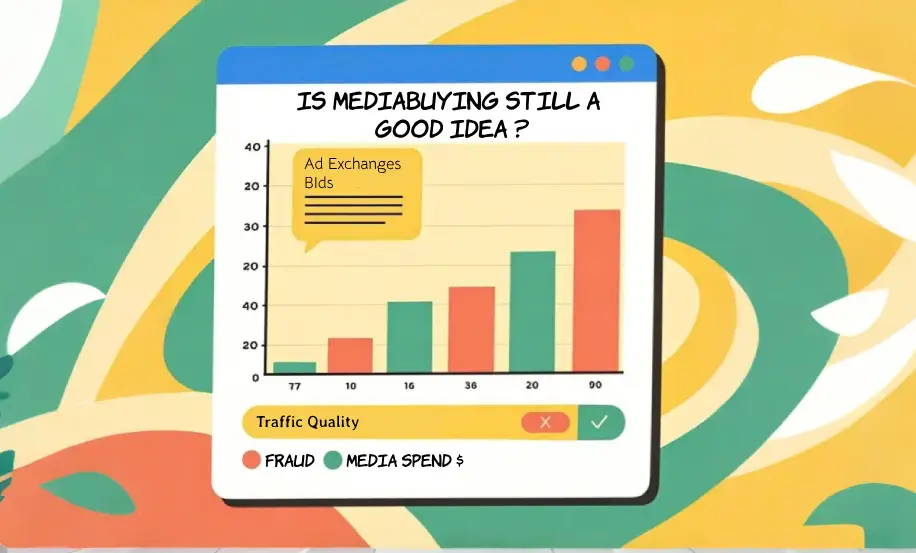The $12.5 Billion Problem Hiding in Your Lead Forms
Your marketing team celebrates 200 new leads this week. Your sales team calls them. Half don’t answer. Of those who do, most claim they never filled out your form. Three use disposable emails. Five came from the same IP address in the last hour.
You’re not alone. The FTC reports businesses lost $12.5 billion to fraud in 2024, and the problem is accelerating. For the first time in internet history, bots now generate 51% of all web traffic according to Imperva’s 2025 Bad Bot Report. That means every second visitor to your website might be automated, and 37% of that traffic is actively malicious.
For performance marketers, affiliate managers, and CMOs, fake leads don’t just waste sales time. They corrupt your data, inflate your cost-per-acquisition, damage relationships with quality partners, and drain 15-25% of your affiliate marketing budget on traffic that will never convert.
The good news? Most fake leads follow predictable patterns. Here’s how to stop them.
1. Screen Affiliates and Partners Before They Access Your Campaigns
The best defense starts before traffic flows. When onboarding new affiliates or traffic partners, implement identity verification that goes beyond a simple signup form.
What to verify:
- Government-issued ID (passport or driver’s license)
- Phone number verification via SMS
- Business website existence and legitimacy
- Domain age and reputation
New domains registered within the last 90 days deserve extra scrutiny. Fraudsters frequently create fresh domains to avoid blacklists. Use 24metrics’ free Domain Scanner to check domain age, risk level, and reputation scores before approving partners.
Most legitimate affiliates expect vetting. If someone resists basic verification, that’s your first red flag.
2. Monitor for Duplicate IP Addresses Over Extended Periods
A single user submitting multiple leads from the same IP within minutes is obvious fraud. But sophisticated operations space out submissions over days or weeks, hoping you won’t notice the pattern.
Set up IP tracking that:
- Records all form submissions with IP addresses
- Flags IPs appearing more than 3 times in 7 days
- Tracks IP patterns across 30-90 day windows
- Compares submission rates against your baseline
Real users occasionally share IPs (offices, universities, VPNs), but if one IP generates 10+ leads in a month while your average is 0.3 leads per IP, you’ve found a problem source. This pattern detection separates legitimate shared IPs from click farms running hundreds of submissions through IP rotation.
3. Detect and Block VPNs, Proxies, and Data Center Traffic
Fraudsters hide behind VPNs and proxies to mask their true location and avoid detection. Data center IPs indicate automated bot traffic rather than real consumers browsing from home or mobile networks.
Check every lead’s IP reputation in real-time. 24metrics’ IP Scanner identifies:
- VPN and proxy connections
- Data center hosting IPs
- Tor exit nodes
- Known bot networks
- Residential vs. non-residential traffic
Establish threshold rules. If more than 10% of traffic from a specific source uses proxies or data centers, you’re dealing with fraud. Quality traffic sources rarely exceed 2-3% proxy usage.
The key metric: compare new traffic sources against your established, converting partners. If your best affiliate generates 3% proxy traffic and a new partner delivers 25%, the quality difference is clear.
4. Benchmark Against Your Quality Sources
Your existing, high-performing traffic sources provide the fraud detection baseline. Calculate these metrics for partners who consistently deliver customers:
- Percentage of duplicate IPs
- Proxy/VPN usage rate
- Email deliverability rate
- Form completion time (too fast indicates bots)
- Geographic distribution
- Device type mix
When evaluating new traffic, compare against these benchmarks. If established partners show 4% duplicate IPs and 2% proxy usage, while a new source delivers 15% duplicates and 12% proxies, you’re seeing fraud.
This benchmarking approach is more reliable than arbitrary rules because it accounts for your specific business, traffic sources, and user behavior patterns.
5. Detect Behavioral Fraud Through Conversion Speed Analysis
Real humans take time to complete forms. Bots and fraudsters don’t. One of the most reliable fraud indicators is comparing form completion time against your baseline traffic sources.
If your quality traffic sources show an average form completion time of 45 seconds, and a new partner delivers leads with a 12-second average, you’re not looking at faster users. You’re looking at automated submissions or incentivized traffic where users rush through without reading because they’re paid per submission rather than genuinely interested in your offer.
Calculate your behavioral baseline:
Track form completion time (from first field interaction to submission) for your top three converting traffic sources over 30 days. This creates your quality benchmark. For most B2B lead forms with 6-8 fields, legitimate completion times range from:
- Simple forms (name, email, phone): 25-40 seconds average
- Standard forms (5-7 fields): 40-65 seconds average
- Complex forms (8+ fields, dropdowns, text areas): 60-120 seconds average
Red flags that indicate behavioral fraud:
Completion time 50%+ below baseline: If your reference sources average 50 seconds and new traffic averages 22 seconds, investigate immediately. Humans read field labels, correct typos, and think about responses. Consistent sub-30-second completions on complex forms indicate copy-paste bots or users incentivized to submit as fast as possible.
Zero variation in timing: Real users show timing variance. One takes 38 seconds, another 67 seconds, another 41 seconds. Bot traffic or form-filling services show suspicious consistency (22 seconds, 23 seconds, 21 seconds, 22 seconds). This uniformity is mathematically impossible with genuine human behavior.
Instant multi-field completion: Track time between field interactions. If a user “completes” all 7 fields within 3 seconds total, you’re watching automated form filling or paste operations, not someone typing information.
Implementation approach:
Add timestamp tracking to your forms at two levels. First, record when a user first interacts with any form field (focus event). Second, record individual timestamps as they move between fields. Calculate total completion time and per-field timing.
Compare new traffic sources against your established baseline weekly. Set alerts when source-level average completion time drops below 70% of your benchmark. If your baseline is 50 seconds and a source shows 32-second average, pause that traffic and investigate.
For bulk analysis of historical traffic, 24metrics’ CSV Importer lets you upload past conversion data to identify patterns across all your traffic sources simultaneously. This reveals which sources have consistently suspicious completion times versus those that maintain healthy behavioral signals.
Remember that mobile users complete forms 15-20% slower than desktop users due to typing speed and screen size. Segment your analysis by device type to avoid false positives from legitimate mobile traffic.
The beauty of behavioral analysis is that fraudsters can fake almost everything – IP addresses, email formats, geographic location, even device fingerprints. But they can’t fake the time it takes a human to read, think, and respond. A 10-second signup on a form that takes real users 60 seconds is not a high-quality lead, regardless of how legitimate the email address appears.
6. Implement Session Replay Software to Analyze User Behavior
Numbers tell part of the story. Watching actual user sessions reveals the rest. Session replay tools like PostHog, Hotjar, or FullStory record how visitors interact with your forms.
What to watch for:
- Instant form fills (humans need 8-12 seconds minimum)
- No mouse movement or scrolling
- Copy-paste behavior on every field
- Submissions at inhuman speeds
- Identical navigation paths across multiple “users”
Review 20-30 sessions from suspicious traffic sources. If you see unnatural patterns like forms completed in 2 seconds with zero mouse movement, you’re watching bot traffic. Real users hesitate, correct typos, scroll to read privacy policies, and exhibit variation in behavior.
Session replay is particularly valuable when training sales teams. Show them the difference between a real lead’s natural browsing session and a bot’s mechanical form completion. This builds organization-wide fraud awareness.
7. Validate Email Addresses at Point of Capture
Email validation stops fake leads before they enter your CRM. Real-time verification during form submission catches:
- Typos and syntax errors
- Disposable email services (Mailinator, TempMail, Guerrilla Mail)
- Role-based emails (info@, admin@, noreply@)
- Non-existent mailboxes
- Catch-all domains that accept any address
24metrics’ Email Scanner provides instant validation with 99% accuracy, identifying whether an email can receive messages and flagging high-risk addresses.
The implementation choice matters. Real-time validation (checking as users type) reduces fake submissions by 60% but may decrease conversion rates by 10-15% if users encounter friction. Batch validation (checking after submission) preserves conversion rates but allows fake leads into your system temporarily.
For high-volume lead generation, real-time validation pays off. For enterprise sales with longer consideration cycles, batch validation with manual review provides better user experience.
8. Watch for Suspicious Conversion Rate Spikes
Your baseline conversion rate is predictable within ranges. When it suddenly jumps above 10% for a specific traffic source, investigate immediately.
Two common scenarios:
Rewarded Traffic: Users complete your form not because they want your product, but because they’re paid per submission by the affiliate. These “leads” have valid emails and pass basic checks, but zero purchase intent.
Brand Bidding Fraud: An affiliate bids on your brand name keywords, intercepts users who already intended to visit your site, and claims credit for conversions that would have happened anyway. This inflates their conversion rate to 15-25% while stealing attribution from direct or organic traffic.
Set up alerts when source-level conversion rates exceed your baseline by more than 50%. If your average is 4% and a partner suddenly delivers 7%, review their traffic immediately.
9. Implement Early KPIs for Fast Quality Assessment
Don’t wait 60 days to determine if traffic is fraudulent. Establish 48-72 hour quality indicators:
Immediate signals (0-48 hours):
- Email deliverability rate
- Phone number connectivity
- Form completion time distribution
- Geographic concentration
Early signals (48-72 hours):
- Email open rates
- Response to follow-up contact attempts
- Sales qualification rate
- First-call connection rate
Quality traffic shows 70%+ email deliverability, 40%+ phone connectivity, and 25%+ response to initial contact within 72 hours. Fraud traffic rarely exceeds 30% on any of these metrics.
These early KPIs let you pause problematic sources before spending thousands on worthless leads.
10. Slow Down or Pause Campaigns When Fraud Indicators Appear
When you detect fraud signals, resist the temptation to “gather more data” while paying for bad traffic. Pause immediately and investigate.
Implement a three-tier response:
Tier 1 – Yellow Flag (one suspicious metric):
Reduce daily cap by 50%, increase monitoring frequency
Tier 2 – Orange Flag (two suspicious metrics):
Pause new traffic, analyze existing submissions, contact the partner for explanation
Tier 3 – Red Flag (three+ suspicious metrics):
Full stop, demand refund or credit, terminate partnership if fraud confirmed
This tiered approach prevents false positives from destroying good partnerships while protecting your budget from sustained fraud.
The financial logic is simple: paying for two more days of fraud while “confirming” costs more than pausing immediately and reactivating if investigation clears the source.
11. Continuously Monitor for Returning Fraudsters
Fraud doesn’t stop after you block a partner. Blocked affiliates gain access to your campaigns through different affiliate networks, sub-affiliate relationships, or by creating new accounts.
Build fraud memory:
- Maintain a database of blocked IPs, email patterns, and device fingerprints
- Share fraud data across your traffic sources when possible
- Monitor for characteristic patterns (submission timing, form fill speed, geographic clustering) that indicate the same fraudster with a new identity
24metrics’ Affiliate Fraud Detection uses device fingerprinting and behavioral analysis to identify fraudsters even when they switch IPs, emails, and affiliate accounts. The system creates unique hashes based on browser characteristics, allowing you to block repeat offenders regardless of surface-level changes.
Expect 10-15% of blocked fraud sources to attempt re-entry within 90 days. Continuous monitoring is not optional for performance marketing at scale.
The ROI of Fraud Prevention
The average advertiser running affiliate campaigns loses 15-25% of spend to fraud. For a business spending $100,000 monthly, that’s $15,000-$25,000 wasted on fake leads that will never become customers.
But the true cost is higher. Each fake lead consumes:
- 15-20 minutes of sales rep time (worth $8-12)
- CRM space and license costs
- Marketing automation sends
- Data quality that corrupts conversion models
- Partnership relationships when you pay commissions on fraud
LexisNexis Research found that every dollar of fraud actually costs businesses $4.45 in total impact. That $20,000 in direct fraud losses becomes $89,000 in total cost when you account for investigation time, lost productivity, and opportunity cost.
The 11 methods above work together as a defense system. Affiliate screening catches obvious fraud before it starts. IP monitoring and proxy detection identify sophisticated operations. Behavioral analysis reveals automated submissions and incentivized traffic. Email validation and session replay confirm suspicions. Conversion monitoring and early KPIs trigger rapid response. Continuous monitoring prevents repeat attacks.
You don’t need to implement all 11 simultaneously. Start with affiliate verification and email validation, add IP monitoring within 30 days, layer in behavioral analysis by day 60. Each addition reduces fraud rates while building toward comprehensive protection.
Your Next Steps
If you’re currently losing budget to fake leads:
- Upload your last 90 days of traffic data using 24metrics’ CSV Importer (free trial available) to analyze your fraud baseline across all sources simultaneously
- Calculate average form completion time for your top 3 converting traffic sources
- Implement real-time email validation on your highest-volume forms
- Set up conversion rate alerts by traffic source
- Begin affiliate verification for all new partnerships
- Review session replay data from your top 5 traffic sources
For marketing teams managing affiliate programs, lead generation campaigns, or performance marketing at scale, 24metrics provides automated fraud prevention that implements these 11 methods across all your traffic sources. The platform detects bots, proxies, duplicate users, and suspicious patterns in real-time, automatically blocking fraud while providing transparency into what’s being stopped and why.
The question isn’t whether you have fraud in your campaigns. If you’re running affiliate marketing or paid lead generation at any scale, you do. The question is whether you’re catching it before it drains your budget and corrupts your data.




